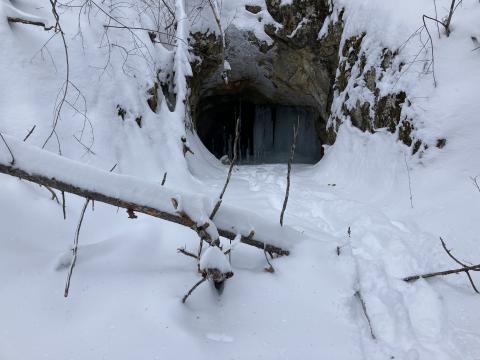Winter Surveys for NH Bats
Over a decade ago (2009) biologists first documented bats with White-nose Syndrome (WNS) in New Hampshire. WNS is named for the white fungus, Pseudogymnoascus destructans, that appears on the muzzle and wings of affected bats while they are hibernating in the winter. The fungus causes bats to wake from hibernation more frequently. This burns up their limited energy reserves, leading to possible starvation and death. Cave-hibernating bats in New Hampshire have been decimated by WNS, and over the past decade winter surveys of bat hibernacula have documented major population declines – nearly 99% for some species.

A hibernating bat
The declines have not been the same for all species. Once our most common hibernating bats, the little brown bat (Myotis lucifugus) and Northern long-eared bat (M. septentrionalis) have been decimated by WNS and they are no longer the most common. Now the species we see most often during winter surveys is the big brown bat (Eptesicus fuscus). Four of the five bat species that hibernate in New Hampshire (all but the big brown bat) are listed as state Endangered; the US Fish and Wildlife Service reclassified the northern long-eared bat as endangered effective January 30, 2023.
Last winter (December 2021-March 2022) New Hampshire bat hibernacula were surveyed to determine the current status of our hibernating bats. A total of five hibernacula were surveyed, yielding observations of just over 100 bats. Three of the five species of bats that hibernate in New Hamsphire were observed, including (in order of decreasing abundance): the big brown bat (Eptesicus fuscus), eastern small-footed bat (Myotis leibii) and the little brown bat (Myotis lucifugus). While we did not observe the Northern long-eared bats or tricolored bats (Perimyotis subflavus) the surveys did reveal a few encouraging discoveries, including hibernacula with little brown bats and eastern small footed bats for the first time in over 10 years.

The entrance to a bat hibernaculum in winter
In addition to the winter surveys, a spring acoustic survey was conducted at a hibernaculum where the entrance to the mine had collapsed. While the mine is no longer accessible to people there are small gaps in the rocks and bats may still use the hibernaculum. The acoustic surveys yielded echolocation sequences of big brown bats.
Our surveys are finding that the number of hibernating bats in New Hampshire remains very low. These findings echo those observed in the region and reported in a recent collaborative study to determine the scope and severity of WNS across the nation. Any recovery will be slow, especially for those species most severely impacted by WNS, so finding a few small glimmers of hope such as the first little brown bat at a hibernaculum in over a decade is encouraging.
For more information on bats in New Hampshire, and how you can help, check out the Taking Action for Wildlife Focus on Wildlife brochure – Bats in New Hampshire (https://extension.unh.edu/resource/bats-new-hampshire) and visit the New Hampshire Fish & Game Department Website at https://www.wildlife.state.nh.us/nongame/bats-nh.html

